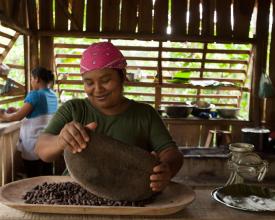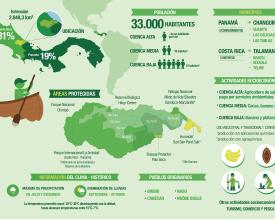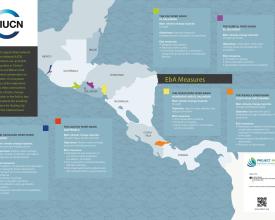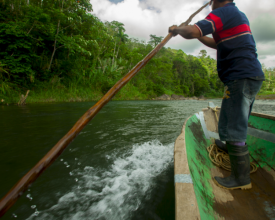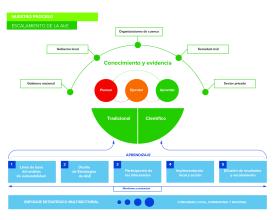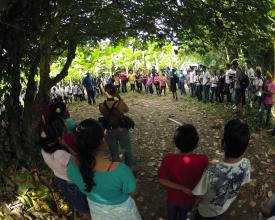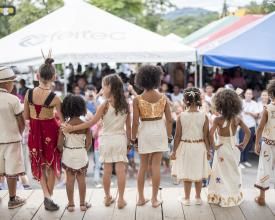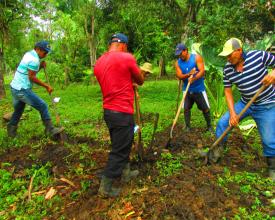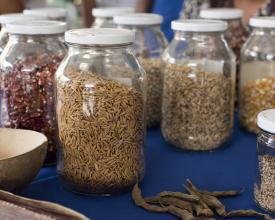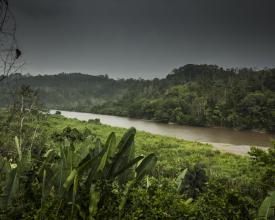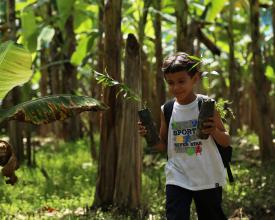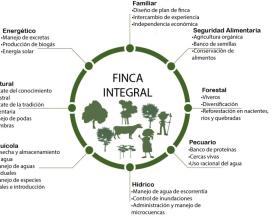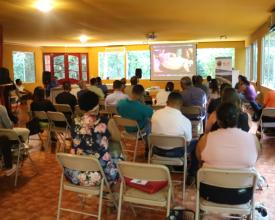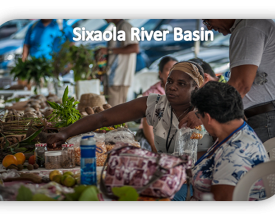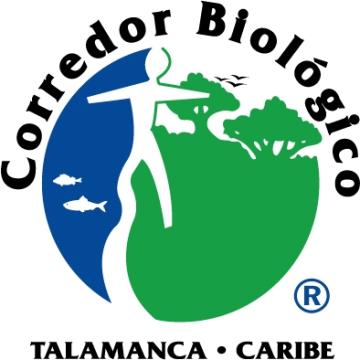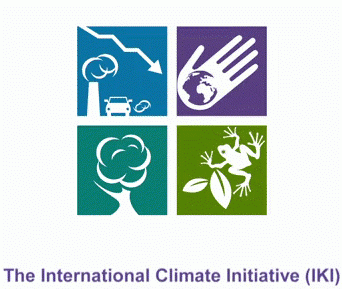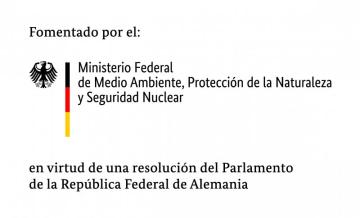
Promotion of agrobiodiversity and riparian restoration in the Sixaola binational river basin
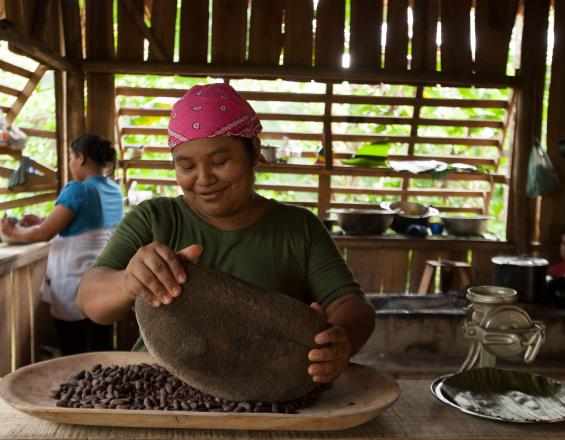
The communities of the Sixaola River basin (2,848 km2), shared between Costa Rica and Panama, are mestizo and indigenous, with high rates of poverty and vulnerability. The area evidences an increasing incidence of extreme climatic events, in particular droughts, high temperatures and floods, which put local livelihoods at risk. A comprehensive solution is proposed to increase socio-environmental resilience that consists of combining dialogue, capacities, knowledge, alliances and field work to promote agrobiodiversity and reforest the basin. With producers from 7 communities, local empowerment and inter-institutional coordination, EbA measures are implemented, their impact on food security is monitored and transboundary cooperation is facilitated. EbA is promoted through "action learning" processes aimed at improving and diversifying productive practices, rescuing the use of autochthonous seeds and restoring riparian forests through bi-national actions.
Context
Challenges addressed
- Habitat fragmentation, heavy rains and poor agricultural practices increase soil erosion, sedimentation and obstruction of waterways, damaging local livelihoods.
- Climatic threats, such as droughts, floods and extreme rains that reduce water quality and affect production, are on the rise.
- In the middle and lower basin, the population is highly dependent on agriculture and faces food insecurity due to crop losses and the degradation of agro-ecosystems.
- There is growing concern about the loss of genetic diversity and traditional knowledge in agriculture with native species.
- The area exhibits high socio-economic vulnerability y marginalization (e.g. lack of economic opportunities and high poverty levels).
- The management capacity of municipalities and indigenous local governments is low and requires greater inter-sectoral coordination and with the central government.
Location
Process
Summary of the process
The solution integrates 3 building blocks (BB): 1. “Action learning”, 2. Community ownership of adaptation measures and 3. Scaling-up, in order to improve food and water security in 7 local communities of a shared watershed. BB1 is transversal since capacity building and the exchange of experiences concern and nourish all BBs, especially when undertaken through a "learning by doing" approach. The implementation of EbA measures at the farm and forest landscape levels (BB2) was part of this learning process, and permitted the resilience of local ecosystems and livelihoods to increase, achieving - on both sides of the border - improvements in riparian forests, productive diversification and the recovery of criollo (native) seeds. BB2 also provided a channel for valuing traditional knowledge and promoting EbA at different governance levels, using field experiences to enrich watershed management and substantiate EbA up-scaling (BB3). Thus, through EbA and governance actions, it was possible to balance immediate benefits to communities to address daily challenges, with a basin-wide vision that, in the medium/long term, consolidates social capital and local decision-making capacities.
Building Blocks
“Action learning” and monitoring to increase capacities and knowledge
In addition to training and supporting communities to implement EbA measures through their productive practices, the aim is to generate evidence on the benefits of these measures and create conditions for their sustainability and up scaling.
- The socio-environmental vulnerability of 7 communities in the Sixaola River basin is examined in order to then identify and prioritize EbA measures.
- Diagnoses are made (productive, socioeconomic and agro-ecological) to identify families with a commitment to transform their farms and select those with the greatest potential to become integral farms.
- Technical support is provided to communities, complemented with traditional knowledge, to ensure that EbA measures contribute to food and water security.
- Exchanges and training are organized for producers (men and women), indigenous authorities, youth and municipalities on climate change, food security, natural resource management, organic fertilizers and soil conservation.
- Monitoring and evaluation is carried out to understand the benefits of EbA measures, and inform horizontal and vertical up-scaling.
- Activities, such as the Agrobiodiversity Fair and binational reforestation events, are carried out collaboratively with local actors.
Enabling factors
- IUCN’s and ACBTC’s years of previous work with the local communities were a key enabling factor to ensure effective and inclusive participation processes, achieve a high level of ownership of EbA measures, and empower stakeholders (in this case, producers, community groups, municipalities and Ministries).
- The binational agreement between Costa Rica and Panama (from 1979 and renewed in 1995) facilitates work at the binational level and inter-sectorial coordination, and endorses the Binational Commission for Sixaola that operates since 2011.
Lesson learned
- Self-diagnosis of vulnerabilities in the face of climate change (in this case, through the CRiSTAL methodology) is a powerful tool that allows communities to jointly prioritize what is most urgent and important and achieves greater collective benefits.
- Applying the "action learning" approach at the community level allows for a better understanding of multiple concepts related to EbA and creates a community of practice that values and takes ownership of adaptation measures.
- It is important to recognize the complementarity between scientific and traditional knowledge for the implementation of EbA measures.
Resources
Community ownership of adaptation measures based on ecosystems and biodiversity
Communities took ownership of the following EbA measures once prioritized and implemented in a participatory manner in the basin:
- Restoration of riparian forests. Binational reforestation events are held involving local communities and schools. These efforts reduce erosion, mitigate the risk of floods, and reinforce cross-border cooperation and local empowerment, including youth. The sustainability of this action is integrated into a reforestation strategy for the middle basin.
- Integral farms / agroforestry systems. Practices are incorporated to manage ecosystem services and generate a high diversity of products (agricultural, forestry and energy). Soil conservation practices and a transition to agroforestry systems with crops and tree diversification, tropical orchards, sowing of basic grains and protein banks are promoted.
- Recovery and valuing of autochthonous seeds and varieties. Agrobiodiversity Fairs are organized to promote the conservation of genetic diversity (criollo seeds) and their traditional knowledge. The impact attributed to the Fair can be seen in the increases in: participation (exhibitors), diversity of species (> 220) and offer of value-added products.
Enabling factors
- The Agrobiodiversity Fair was born out of the need, identified by communities, to highlight the importance of genetic diversity for local livelihoods and adaptation.
- Since its first organization in 2012, the Fair is becoming notorious, and consolidated, with the involvement of more and more institutions (indigenous associations; municipalities; government institutions such as ministries, institutes for rural development, learning or agricultural research; universities; and the CBCRS) as well as visitors.
Lesson learned
- Local wisdom relating to climate variability and extreme events, comes from traditional knowledge on resilience and adaptation, and is a key ingredient in building community responses to climate change.
- Working with families was an effective model, as was the promotion of 9 demonstrative integral farms (replicated in 31 new farms). The integral farm produces a high diversity of products (agricultural, forestry and energy) and optimizes the management of natural resources. If it is framed at the landscape level, this production model consolidates the EbA approach and facilitates its scaling up.
- The Agrobiodiversity Fair turned out to be a valuable space for producers; there they can create direct contacts for exchanging experiences, information and genetic material, and so there is a growing number of exhibitors that come from more and more communities.
- The level of institutional commitment observed in the organizations involved, gives importance to the conservation and rescue of native seeds and their relationship with adaptation.
Scaling-up and sustainability of adaptation measures
Promoting EbA measures with a high level of community involvement and binational ties was an effective way to achieve greater interaction between community, municipal and national actors, and also between peers (network of resilient producers; local government encounter). The results are, on the one hand, greater local empowerment, and on the other, scaling-up of EbA measures both vertically and horizontally. Thus, contributions are made towards institutionalizing EbA and creating conditions for its sustainability. The replication of the integral farm model arose from networking between producers, communities and local governments, and from a regional project with the Binational Commission of the Sixaola River Basin (CBCRS) that provided the financing. The Agrobiodiversity Fair, the work of producers as a network, and the Binational Reforestation Events, which are now all under the auspices of local and national institutions, were important mobilizing forces of change and spaces for exchange and learning. In the vertical sense, the scaling-up of EbA included working with the CBCRS to integrate EbA in the Strategic Plan for Transboundary Territorial Development (2017-2021), and with MINAE in the National Climate Change Adaptation Policy of Costa Rica.
Enabling factors
- Much of the work was accomplished thanks to the channelling and guiding role of the CBCRS (created in 2009) as a binational platform for governance and dialogue, and the ACBTC as a local development association. Both advocate for local and territorial interests and know the gaps and needs that exist in the area, and with this project were able to address the challenges that communities face and improve governance in the basin, promoting an ecosystem approach and a broad participation of actors.
Lesson learned
- Coordinating efforts through the CBCRS has shown that it is more cost-effective to work with existing structures and governance bodies, with powers and interests in the good management of natural resources and in achieving an appropriate representation of key actors, than to aim to create new groups or committees to deal with EbA issues.
- Improving multilevel and multisectoral governance is a fundamental part of effective adaptation. Here, the role of subnational governments (such as municipalities) needs to be underscored, since they have a mandate in the management of the territory, but also responsibilities in the implementation of national adaptation policies and programs (e.g. NDCs and NAPs).
- The identification of spokespersons and leaders (amongst men, women and youth) is an important factor in effectively fomenting the uptake and up-scaling of EbA.
Impacts
- The integral farm system was implemented, and later replicated, to increase the provision of food, soil formation and erosion control.
- Increase in the capacities of: 40 farmers who implement integral farms and agroforestry systems, 20 young people trained in climate change who lead projects in their communities, 3 municipalities and> 200 people trained in EbA, governance for adaptation, and water management.
- Increased dialogue, exchange, awareness and appreciation of biodiversity thanks to the annual Agrobiodiversity Fair (> 1000 people) with exchange of native seeds among> 100 farmers since 2015.
- 7,500 native trees planted in annual binational reforestation events to recover riverbank forests.
- Evidence on the benefits of the EbA for food security, applying a monitoring and evaluation methodology in 9 integrated farms.
- Social capital strengthened, with communities and producers better organized and informed.
- Commitments taken on by inter-institutional entities to give sustainability to the actions.
- Upscaling of EbA actions and lessons learned through a network of resilient producers (40 farms), the Binational Commission of the Sixaola River Basin and the entities responsible for climate change policies at multiple levels of government.
Beneficiaries
- 7 communities (~400 people) including Bri Bri y Cabécar indigenes: Yorkín, Shuabb, Catarina, Paraíso (Costa Rica). El Guabo, Washout, Barranco (Panama)
- Sixaola Binational Commission
- Municipalities of Talamanca y Changuinola (~33,000 inhab.)
Sustainable Development Goals
Story

The indigenous and mestizo communities of the Sixaola River basin depend heavily on subsistence agriculture (basic grains) and the cultivation of cocoa, banana and plantain. However, climatic variability is affecting production, due to both extreme events and higher incidence of pests and diseases in crops, and to changes in the flow of the Sixaola River. During droughts, the middle basin becomes unnavigable, hindering the commercialization of products, while, with extreme rainfall, the high amounts of sediment make navigation dangerous and decrease water quality. This, combined with poor agricultural practices, made it necessary to introduce EbA measures in farms and riverbanks to reduce erosion, restore riparian forests and diversify production and thus increase the resilience of agro-ecosystems and food security. The communities value traditional knowledge and wanted to promote the use of native species, adapted to local conditions, so that all EbA measures implemented used native species and/or autochthonous seeds.
Jeimy Carranza (BriBri): "In the context of climate change, the issue of native seeds conservation, integral farms and family farming is very important. It is a matter that has long been demonstrating that it has positive impacts on the environment ...... Integral farms and family agriculture are ways to restore the landscape. So the more initiatives like these we have in the binational basin, [the more] communities will be in better capacity to recover or to resist negative climate change events."
Milton Hernández (Yorkin): “Now I am seeing what is really important, that this has led me to make a change in me, personally. I now arrive at my farm, what a beauty! I see it myself. I have this, I have the other, I have the other, I have ... Before I did not have it. And we do have land to make a very good farm. Now we are seeing it. And I'm very happy about that.”
Miriam Morales (Yorkin): "For us the Fair is very important because that way, we can collect seeds; and the seeds are from here, from the area, and sometimes we don’t grow crops and they get lost, so this way we can rescue the lost seeds ... It's a way that one can also share with other producers, and share seeds, because that's also in our culture. When we have seeds, we are always exchanging them... "
